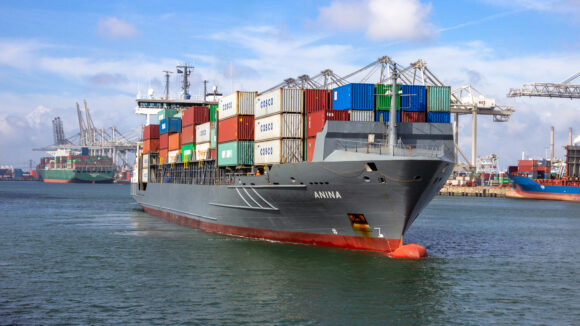The maritime sector experienced fewer total losses of vessels in 2022 while the number of shipping incidents remained relatively consistent, according to a recent report.
Allianz Global Corporate & Specialty (AGCS) published its Safety and Shipping Review 2023, an annual review of trends and developments in shipping losses and safety. The review shows 38 losses of vessels (over 100 gross tonnage) during 2022, compared with 59 the year prior.
The number of shipping casualties or incidents was 3,032 in 2022 compared to 3,000 the year prior. Machinery damage/failure was the most common cause of incident (1,478), followed by collision (280), fire/explosion (209) and wrecked/stranded (209).
Overview
The South China Sea region, which includes Indochina, Indonesia and the Philippines, is the global loss hotspot for total losses. In 2022, nearly one in four total losses (10) occurred in the region. High levels of trade, congested ports, older fleets and extreme weather drove the number of total losses.
“The density of the number of vessels that is moving through that area is just phenomenal,” said Captain Randy Lund, senior marine risk consultant at AGCS. “There are still some poor ships operating out there, whether it’s because of their maintenance, their history or the age of the ship.”
Cargo, fishing and passenger vessels account for over 60% of ships lost over the past decade. The average age of a vessel involved in a total loss in the past decade is 29 years.
Annual shipping losses have declined by two-thirds over the past 10 years, reflecting improvements in maritime safety.
The number of casualties and incidents meantime increased year-on-year in seven of the top 10 shipping regions. The British Isles region reported the highest number of reported incidents (679).
Fire Safety
Incidents involving fire grew 17% in 2022 from the prior year. Fire is the most expensive cause of marine insurance claim and has caused 64 total losses in the past five years.
Decarbonization is driving demand for electric vehicles (EVs) and battery-powered goods. The presence of Lithium-Ion (Li-Ion) batteries used in EVs brings the risk of ‘thermal runaway’ a self-heating fire that can cause an explosion.
“With those kinds of fires, it’s all about the propagation from one electric vehicle to the next one,” said Lund. “Because they burn so hot for such a long duration and they’re very hard to contain, it’s very likely that the loss to the vessel is going to be extreme.”
An AGCS analysis of approximately 250,000 marine insurance industry claims shows that fire is the most expensive cause, accounting for 18% of the value of all analyzed claims. Hazardous and combustible cargo are increasingly transported on large vessels, which enhances the risk of severe losses.
While Li-Ion fire risks will likely ease over time, AGCS recommends attention be focused on pre-emptive measures to help mitigate the peril, such as ensuring staff/crew receive adequate training, improving early detection systems and developing hazard control and emergency plans.
Russia-Ukraine War Fallout
The one-year mark of Russia’s war with Ukraine marked a trigger for marine insurance policies, Allianz experts say. A marine war risk policy states a vessel could be considered a total loss when trapped or blocked for a defined period, typically one year for a hull policy but as little as six months for cargo.
As the war passed the 12-month period this spring, outstanding claims for trapped vessels have been declared as total losses, said Régis Broudin, Global Head of Marine Claims at AGCS.
“In almost 30 years of experience, this is the first time I have seen this theoretical total loss scenario realized under a blocking and trapping hull cover,” said Broudin. This situation is unprecedented.”
Insureds would be expected to take reasonable measures to try minimizing losses, such as making use of any safety passage agreements.
Western bans on Russian oil imports have led to unregulated oil transfers at sea performed by “shadow” tanker fleets. Shadow fleets carry oil from Russia to aligned countries such as China and North Korea. Shadow fleets will turn off their automatic identification system to avoid detection.
Vessels in such fleets are more likely to be older ships operating under lower maintenance standards. Their presence brings more risks to sea. According to AGCS analysis of ship tracking and accident data, there were at least eight groundings, collisions or near missies involving tankers carrying sanctioned oil products in 2022, the same number as in the previous three years combined.
Economic outlook
A post-pandemic demand for container shipping has subsided, leaving maritime transportation in choppy economic waters.
The cost of shipping a container between Asia and the U.S. or Europe in April was more than 80% lower than a year earlier. The Baltic and International Maritime Council expects weak demand for container shipping outstripping supply for the rest of 2023.
A decline in freight rates could lead to cost-cutting in maintenance levels and lower risk management budgets, said Justus Heinrich, global product leader marine mull at AGCS.
“In prior downturns, investment in vessel maintenance has not always been at the required level, leading to losses and an increase in machinery claims,” Heinrich said.
One potential positive effect of the downturn in freight rates is shipowners are likely to scrap older vessels. Scrapping all but stopped after the Covid-19 pandemic as demand for vessels soared, said Heinrich, resulting in many vessels operating beyond their usual life expectancy.
Older vessels tend to be smaller, while newer ones can carry more cargo. The capacity of the largest container vessels has more than doubled in the last two decades. Newer vessels also have improved propulsion and navigation systems.
The shift to larger vessels can lead to narrow, congested shipping lanes, particularly in the already dense South China Sea. A large vessel that experiences a fire or cargo incident likely takes longer time to resolve, leading to increased delays for cargo owners.
Still, newer vessels with improved technology are preferable to older ships.
“From an insurance aspect,” Lund said, “we like to see new ships as opposed to ships that are 20 years old trying to make it.”
Photo: Container ship leaving a shipping container terminal in the Port Of Rotterdam.
Source: Allianz Global Corporate & Specialty (AGCS)
Was this article valuable?
Here are more articles you may enjoy.



 MAPFRE Accuses AAA of Violating Long-Time Exclusive Marketing Agreement
MAPFRE Accuses AAA of Violating Long-Time Exclusive Marketing Agreement  Experian: AI Agents Could Overtake Human Error as Major Cause of Data Breaches
Experian: AI Agents Could Overtake Human Error as Major Cause of Data Breaches  Consumer Acceptance of Telematics Widens, Says Survey
Consumer Acceptance of Telematics Widens, Says Survey  10 Highest Class-Action Settlements in 2025 Eclipsed $70B Total: Duane Morris
10 Highest Class-Action Settlements in 2025 Eclipsed $70B Total: Duane Morris 


